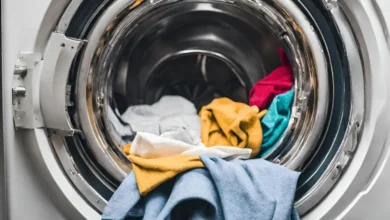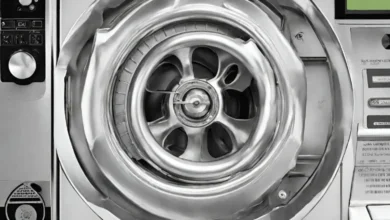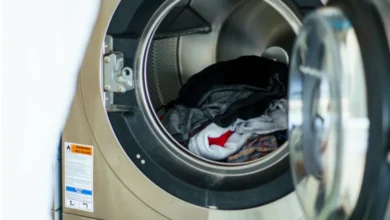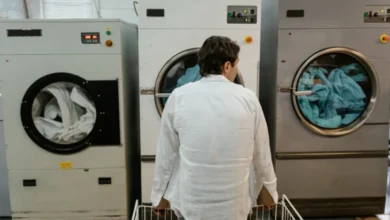Fully Automatic vs. Semi-Automatic Washing Machines: A Comprehensive Cost Analysis

In the realm of household appliances, the washing machine stands out as a quintessential tool, making the laundry chore more manageable and efficient. When it comes to purchasing a washing machine, one of the primary decisions is whether to opt for a fully automatic or a semi-automatic model. Both types come with their unique features, advantages, and, of course, varying costs. In this detailed analysis, we will delve into the intricacies of fully automatic and semi-automatic washing machines, examining not only the upfront expenses but also the long-term considerations that can impact your overall cost of ownership.
I. Understanding the Basics
A. Fully Automatic Washing Machines
Fully automatic washing machines, as the name implies, are designed to automate the entire laundry process. They come in two main types: front-loading and top-loading. The distinguishing factor lies in the loading mechanism, affecting factors such as space requirements and loading convenience.
- Front-Loading Fully Automatic Machines
- Features:
- Front-loading machines typically boast advanced features such as higher spin speeds, better water efficiency, and enhanced washing programs.
- These machines are often equipped with a variety of wash cycles, temperature settings, and specialized options for different fabrics.
- Front loaders are known for their sleek design and are generally more energy-efficient compared to top loaders.
- Cost Considerations:
- Front-loading fully automatic machines tend to be pricier upfront due to their advanced technology and features.
- However, their efficiency can lead to potential long-term savings in terms of water and energy consumption.
- Top-Loading Fully Automatic Machines
- Features:
- Top-loading machines are known for their convenience, allowing users to add or remove clothes even mid-cycle.
- While they may not offer the same efficiency as front loaders, they are still equipped with various wash programs and settings.
- Cost Considerations:
- Top-loading fully automatic machines generally have a more varied price range, starting from around $300 for basic models and going up to $1200 or more for high-capacity and feature-rich options.
B. Semi-Automatic Washing Machines
Semi-automatic washing machines, on the other hand, provide a more hands-on approach to laundry. They are divided into two compartments: one for washing and the other for drying. Users need to manually transfer clothes from the wash compartment to the dryer after the washing cycle completes.
- Features:
- Semi-automatic machines come with basic wash settings and may lack the advanced features found in fully automatic models.
- Users have more control over the washing process, allowing for customization based on personal preferences.
- Cost Considerations:
- Semi-automatic washing machines are generally more affordable upfront, making them an attractive option for budget-conscious consumers.
- The affordability of semi-automatic machines makes them an attractive option for those on a tight budget.
II. Upfront Costs
A. Initial Investment
1. Fully Automatic Washing Machines
- Front-loading fully automatic machines typically have a higher upfront cost, often ranging from $500 to $1500, depending on brand, features, and capacity.
- Top-loading fully automatic machines have a more diverse price range, starting from around $300 for basic models and going up to $1200 or more for high-capacity and feature-rich options.
2. Semi-Automatic Washing Machines
- Semi-automatic machines are generally more budget-friendly, with prices ranging from $150 to $500.
- The affordability of semi-automatic machines makes them an attractive option for those on a tight budget.
B. Installation and Maintenance
1. Fully Automatic Washing Machines
- Installation of fully automatic machines may require professional assistance, potentially incurring additional costs.
- Regular maintenance costs may include occasional servicing and potential repairs, depending on the machine’s complexity.
2. Semi-Automatic Washing Machines
- Semi-automatic machines are usually easier to install, often requiring minimal professional assistance.
- Maintenance costs for semi-automatic machines are generally lower, as they have fewer complex components.
C. Additional Considerations for Upfront Costs
While the initial investment and installation costs are significant factors, it’s crucial to consider additional expenses that may arise during the purchasing process. These include warranty costs, extended service plans, and any accessories or additional features that you might want to add to enhance the functionality of your chosen washing machine.
Also Read: Best Washing Machine in India
III. Operational Costs
A. Energy Efficiency
1. Fully Automatic Washing Machines
- Front-loading fully automatic machines are known for their energy efficiency, typically consuming less water and electricity per cycle.
- High spin speeds in front loaders contribute to more efficient water extraction, reducing drying time and energy consumption.
2. Semi-Automatic Washing Machines
- Semi-automatic machines may have varying energy efficiency levels, with some models consuming more water and electricity compared to their fully automatic counterparts.
- The manual transfer of clothes from wash to dry compartment can lead to increased energy consumption during the drying phase.
B. Water Consumption
1. Fully Automatic Washing Machines
- Front-loading fully automatic machines generally use less water compared to top loaders and semi-automatic machines.
- Water-efficient features contribute to reduced water bills over time.
2. Semi-Automatic Washing Machines
- Semi-automatic machines may use more water, especially if users are not mindful of the water level settings.
- The need for manual intervention in the washing process may result in less efficient water usage.
C. Detergents and Additives
Consideration should be given to the type and quantity of detergents and laundry additives required for each type of machine. Fully automatic machines often require specific high-efficiency detergents, while semi-automatic machines may be more forgiving in terms of detergent choice. Over time, these costs can accumulate and impact the overall operational expenses.
IV. Long-Term Considerations
A. Time and Convenience
1. Fully Automatic Washing Machines
- The automated nature of fully automatic machines saves considerable time and effort.
- Users can set the machine, walk away, and return to freshly washed and sometimes dried clothes.
2. Semi-Automatic Washing Machines
- Semi-automatic machines require more manual involvement, which may be time-consuming.
- Users need to allocate time for transferring clothes between compartments and monitoring the washing and drying cycles.
B. Lifespan and Durability
1. Fully Automatic Washing Machines
- High-quality fully automatic machines are built to last, offering a longer lifespan compared to some semi-automatic models.
- Durability contributes to long-term cost savings by reducing the frequency of replacements.
2. Semi-Automatic Washing Machines
- While semi-automatic machines are generally durable, their manual components may be prone to wear and tear over time.
- Regular maintenance can help extend the lifespan of these machines.
C. Repairs and Replacement Costs
Consider the potential costs associated with repairs and replacements. Fully automatic machines, with their advanced technology, might incur higher repair costs. However, they often come with more extensive warranties. Semi-automatic machines, while generally more straightforward, might have lower upfront repair costs but could require more frequent attention over their lifespan.
V. Environmental Impact
A. Sustainability of Fully Automatic Machines
1. Energy Star Ratings
- Fully automatic machines, especially front loaders, often come with Energy Star ratings, signifying high energy efficiency.
- This can contribute to a lower environmental impact by reducing overall energy consumption.
2. Water Conservation Features
- Water-saving features in fully automatic machines, such as precise water level control, can help minimize water wastage, aligning with sustainable practices.
B. Semi-Automatic Machines and Sustainability
1. Manual Water Control
- Semi-automatic machines, depending on the user’s diligence, may result in less efficient water usage due to manual water control.
- Consistent monitoring is essential to minimize water waste and promote sustainability.
VI. Smart Technology Integration
A. Smart Features in Fully Automatic Machines
1. Connectivity and Control
- Many fully automatic machines come with smart features, allowing users to control and monitor the washing process remotely.
- Smart technology integration can enhance user convenience but may add to the overall cost.
2. Energy Optimization
- Smart sensors in some fully automatic machines optimize energy usage based on the load size and fabric type, contributing to long-term efficiency.
B. Semi-Automatic Machines and Smart Features
1. Limited Smart Capabilities
- Semi-automatic machines generally lack advanced smart features.
- The absence of such features may appeal to users seeking simplicity but could mean missing out on certain conveniences.
VII. Consumer Reviews and Satisfaction
A. Fully Automatic Machine Reviews
1. User Satisfaction
- Fully automatic machines often receive positive reviews for their convenience and efficiency.
- User satisfaction is often linked to the machine’s ability to deliver consistent results over time.
2. Common Complaints
- Some users may report issues such as high repair costs for fully automatic machines, especially after the warranty period expires.
- Varied experiences highlight the importance of thorough research before making a purchase.
B. Semi-Automatic Machine Reviews
1. Affordability
- Semi-automatic machines are praised for their affordability and straightforward operation.
- Users appreciate the lower initial investment but may mention the trade-off in terms of manual effort.
2. Durability
- Durability is often cited as a positive aspect of semi-automatic machines, with users noting their machines’ longevity with proper maintenance.
VIII. Making the Decision
A. Consider Your Priorities
1. Time vs. Budget
- If time-saving convenience is a top priority and budget allows, a fully automatic machine may be the preferred choice.
- For those prioritizing budget over automated features, a semi-automatic machine could be a practical solution.
2. Sustainability Goals
- Users with a focus on environmental impact may lean towards fully automatic machines with high energy efficiency ratings.
- Those seeking a balance between sustainability and manual control might opt for a semi-automatic machine with water-saving features.
B. Size and Household Needs
1. Family Size
- Larger families with higher laundry demands may benefit from the efficiency and capacity of fully automatic machines.
- Smaller households or individuals might find a semi-automatic machine sufficient for their needs.
2. Space Considerations
- Front-loading fully automatic machines may be more suitable for compact spaces due to their stackable design.
- Top-loading fully automatic machines and semi-automatic machines may require more floor space.
IX. Environmental Impact
A. Sustainability of Fully Automatic Machines
1. Energy Star Ratings
- Fully automatic machines, especially front loaders, often come with Energy Star ratings, signifying high energy efficiency.
- This can contribute to a lower environmental impact by reducing overall energy consumption.
2. Water Conservation Features
- Water-saving features in fully automatic machines, such as precise water level control, can help minimize water wastage, aligning with sustainable practices.
B. Semi-Automatic Machines and Sustainability
1. Manual Water Control
- Semi-automatic machines, depending on the user’s diligence, may result in less efficient water usage due to manual water control.
- Consistent monitoring is essential to minimize water waste and promote sustainability.
X. Smart Technology Integration
A. Smart Features in Fully Automatic Machines
1. Connectivity and Control
- Many fully automatic machines come with smart features, allowing users to control and monitor the washing process remotely.
- Smart technology integration can enhance user convenience but may add to the overall cost.
2. Energy Optimization
- Smart sensors in some fully automatic machines optimize energy usage based on the load size and fabric type, contributing to long-term efficiency.
B. Semi-Automatic Machines and Smart Features
1. Limited Smart Capabilities
- Semi-automatic machines generally lack advanced smart features.
- The absence of such features may appeal to users seeking simplicity but could mean missing out on certain conveniences.
XI. Consumer Reviews and Satisfaction
A. Fully Automatic Machine Reviews
1. User Satisfaction
- Fully automatic machines often receive positive reviews for their convenience and efficiency.
- User satisfaction is often linked to the machine’s ability to deliver consistent results over time.
2. Common Complaints
- Some users may report issues such as high repair costs for fully automatic machines, especially after the warranty period expires.
- Varied experiences highlight the importance of thorough research before making a purchase.
B. Semi-Automatic Machine Reviews
1. Affordability
- Semi-automatic machines are praised for their affordability and straightforward operation.
- Users appreciate the lower initial investment but may mention the trade-off in terms of manual effort.
2. Durability
- Durability is often cited as a positive aspect of semi-automatic machines, with users noting their machines’ longevity with proper maintenance.
XII. Environmental Impact
A. Sustainability of Fully Automatic Machines
1. Energy Star Ratings
- Fully automatic machines, especially front loaders, often come with Energy Star ratings, signifying high energy efficiency.
- This can contribute to a lower environmental impact by reducing overall energy consumption.
2. Water Conservation Features
- Water-saving features in fully automatic machines, such as precise water level control, can help minimize water wastage, aligning with sustainable practices.
B. Semi-Automatic Machines and Sustainability
1. Manual Water Control
- Semi-automatic machines, depending on the user’s diligence, may result in less efficient water usage due to manual water control.
- Consistent monitoring is essential to minimize water waste and promote sustainability.
XIII. Smart Technology Integration
A. Smart Features in Fully Automatic Machines
1. Connectivity and Control
- Many fully automatic machines come with smart features, allowing users to control and monitor the washing process remotely.
- Smart technology integration can enhance user convenience but may add to the overall cost.
2. Energy Optimization
- Smart sensors in some fully automatic machines optimize energy usage based on the load size and fabric type, contributing to long-term efficiency.
B. Semi-Automatic Machines and Smart Features
1. Limited Smart Capabilities
- Semi-automatic machines generally lack advanced smart features.
- The absence of such features may appeal to users seeking simplicity but could mean missing out on certain conveniences.
XIV. Final Thoughts
As you navigate the decision between fully automatic and semi-automatic washing machines, it’s essential to recognize that the ideal choice varies based on individual preferences and circumstances. Careful consideration of upfront costs, operational efficiency, sustainability features, and long-term considerations will guide you towards a decision that aligns with your specific needs. Whether you prioritize the time-saving convenience of fully automatic machines or the budget-friendly simplicity of semi-automatic options, your choice will undoubtedly impact your daily life and contribute to the overall efficiency and sustainability of your household.






